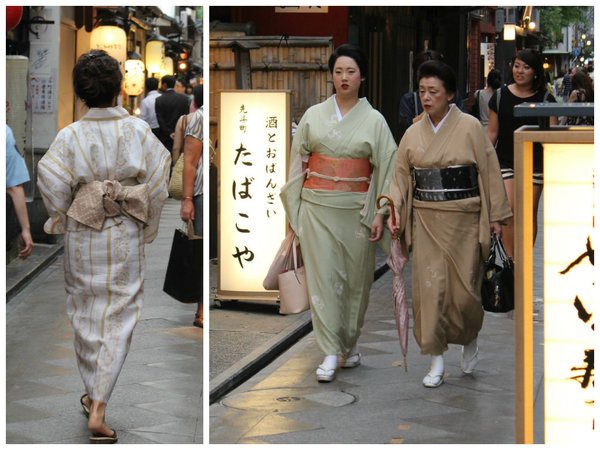Kimono
The word Kimono means “a thing to wear” and could there be any-thing more beautiful to wear than a kimono! I have always been fascinated by the style and history of kimono and my trip to Japan this summer gave me an up close and personal look at how Japanese women still wear these amazing garments. I saw some priceless kimono in exquisite silks with masterful designs hang in the national museums in Tokyo, I saw the brightly coloured and fun styles that Japanese women wear to temples dressed up with flowers in their hair (pictured above) and I saw how women going about their everyday business on the streets wear them (pictured below). I also went in search of the theatrical kind of kimono worn by the Geisha and Maiko in Kyoto- although I didn’t get to see a real Geisha. I even tried some kimono in a Ryokan for a day and brought some beautiful vintage ones home. Here’s a picture story of what I discovered.
Kimono in the temples
Young Japanese men and women visit the Buddhist temples and Shinto shrines which are dotted all around the city of Kyoto wearing beautifully coloured Kimono. They dress up, I imagine, for the occasion of visiting the shrines, as a day out and to celebrate graduation season. The cotton summer kimono, called yukuta kimono are bright modern and colourful their fabrics are more breathable and not as restrictive as other kimono but all are worn with contrast obi belts and thonged sandals. I took this photo of the girls above in the Kiyomizu-dera Temple in Kyoto– I loved how the traditional mixed with the technology.
Kimono on the street
Japanese women still wear Kimono on the street, out shopping and on the subways in Tokyo and Kyoto. Older women can often be seen in them and the designs are more practical and in much more muted soft colours than the gaiety of the bright yukata youngsters wear. According to the Victoria & Albert museum in London “The 21st century has witnessed something of a kimono renaissance. Elegant kimono in beautiful modern fabrics can be seen increasingly on the streets of Japan, while second-hand kimono are becoming popular with the young, who often re-style them or combine them with other items of dress. The resurgence of interest in kimono is particularly apparent in the summer, when department stores are full of yukata (summer kimono), which are much simpler to wear than formal garments. After the Second World War kimono were often viewed as a product of Japan’s feudal past or a symbol of woman’s oppression, but today they are just another choice in a woman’s – and even occasionally a man’s – wardrobe. They are an item of fashion, just as they were in their Edo heyday.”
The Kimono & me
The pink kimono I am wearing above is a full length kimono with a pretty fan pattern dotted throughout. I bought it in a vintage store in Tokyo for a snip. I wore it for the first time for Film Fatale’s 1920s Halloween Prohibition Party in IMMA last Halloween night. This kimono is full length but I pinned it up to protect the fabric and to give it a 1920s look. It is lined in white silk and the hem is a contrasting dip dyed pink.
See more from the V&A on the Japanese Kimono and its history here
Even Geisha are blogging, here’s a real Geishas blog.
See research on Japan culture on my Pinterest board here.
Kimono details
All photos by Ruth Griffin taken with Canon EOS 600D in Japan 2014. Kimono & Me phone iPhone 5.





